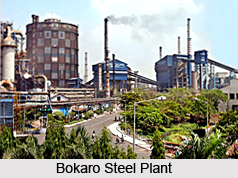 Bokaro Steel Plant is the fourth integrated plant in the Public Sector. It began taking shape in the year 1965 in collaboration with the Soviet Union. This steel plant in Jharkhand was originally incorporated as a limited company on 29th January 1964, and was later merged with SAIL, first as a subsidiary and then as a unit, through the Public Sector Iron and Steel Companies (Restructuring & Miscellaneous Provisions) Act 1978. The construction work started on 6th April 1968.
Bokaro Steel Plant is the fourth integrated plant in the Public Sector. It began taking shape in the year 1965 in collaboration with the Soviet Union. This steel plant in Jharkhand was originally incorporated as a limited company on 29th January 1964, and was later merged with SAIL, first as a subsidiary and then as a unit, through the Public Sector Iron and Steel Companies (Restructuring & Miscellaneous Provisions) Act 1978. The construction work started on 6th April 1968.
Bokaro Steel Plant is considered to be the first swadeshi steel plant in India. it has been built with maximum indigenous content in terms of equipment, material and know-how. Its first Blast Furnace started on 2nd October 1972 and the first phase of 1.7 MT ingots steel was completed on 26th February 1978 with the commissioning of the third Blast Furnace. All units of 4 MT stage have already been commissioned and the 90s` modernisation has further upgraded this to 4.5 MT of liquid steel.
The new features added in modernisation of SMS-II include two twin-strand slab casters along with a Steel Refining Unit. The Steel Refining Unit was inaugurated on 19th September, 1997 and the Continuous Casting Machine on 25th April, 1998. The modernisation of the Hot Strip Mill saw addition of new features like high pressure de-scalers, work roll bending, hydraulic automatic gauge control, quick work roll change, laminar cooling etc. New walking beam reheating furnaces are replacing the less efficient pusher type furnaces. A new hydraulic coiler has been added and two of the existing ones revamped. With the completion of Hot Strip Mill modernisation, Bokaro is producing top quality hot rolled products that are well accepted in the global market.
Bokaro Steel Plant is designed to produce flat products like Hot Rolled Coils, Hot Rolled Plates, Hot Rolled Sheets, Cold Rolled Coils, Cold Rolled Sheets, Tin Mill Black Plates (TMBP) and Galvanised Plain and Corrugated (GP/GC) Sheets. Bokaro has provided a strong raw material base for a variety of modern engineering industries including automobile, pipe and tube, LPG cylinder, barrel and drum producing industries.
The prime objective of Bokaro Steel Plant as a company is to work towards becoming a one-stop-shop for world-class flat steel in India. Further modernisation plans are aimed at increasing the liquid steel production capacity, coupled with fresh rolling and coating facilities.















